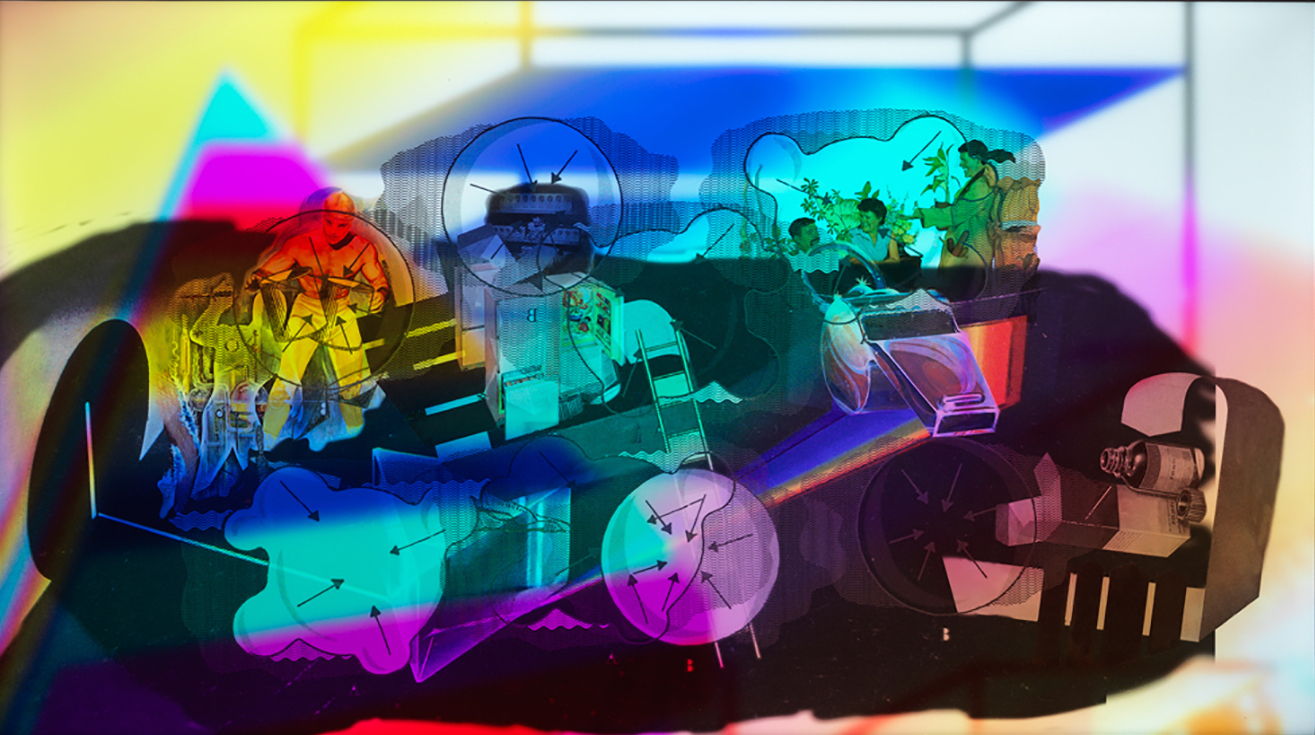

Jibade-Khalil Huffman is an artist and writer whose video and photo works use found, archival material and contemporary ephemera to address slippage in memory and language, particular to race and visibility. Lyrical strophes of text and densely-composed imagery produce objects of perpetual flux, indexed by accumulating layers which challenge normative symbolic and semiotic hierarchies. Through projection and repetition, Huffman’s work evokes the untranslatable, ruminating on the liminal qualities of singular experiences through narrative and graphic rhythms.
Recent exhibitions include the Wexner Center for the Arts, Tufts University Galleries, Ballroom Marfa, The Kitchen, MoCA Tucson, Swiss Institute, New York, Portland Institute of Contemporary Art, The Jewish Museum, Institute of Contemporary Art, Philadelphia, The Studio Museum in Harlem and the Hammer Museum. Educated at Bard College (BA), Brown University (MFA, Literary Arts), and USC (MFA, Studio Art), his awards include the Grolier Poetry Prize, the Jerome Foundation Travel Grant and fellowships from Bemis Center for Contemporary Arts, the Lighthouse Works, Lower Manhattan Cultural Council and the Millay Colony for the Arts. Huffman was a 2015-16 Artist in Residence at the Studio Museum in Harlem and lives and works in North Carolina and Los Angeles.
For more information, visit anatebgi.com/cpt_artists/jibade-khalil-huffman/#image-one
Jibade-Khalil Huffman: You Are Here
by Katie McCampbell Hirsch
Jibade-Khalil Huffman’s work defies definition. His video work is sculptural. His prints hum with electricity. Cut outs in walls are enlivened with projections. Text is given equal weight as a visual. In this newest iteration, commissioned by the Halsey Institute of Contemporary Art and set to expand over a series of forthcoming exhibitions, Huffman’s work draws on all senses, utilizing film, print, audio, text, and the ultimate tool: the viewer’s own experience.
Trained as a poet and an artist, Huffman’s work is the answer to his own ever evolving stream of internal questions about how culture functions and communicates. Although each new project is approached as its own unit, Huffman’s work continually considers how Black Americans are seen and see themselves, and their collective engagement with societal trauma. Using both original and found footage and imagery to build on shared iconography of popular television shows, video games, and other familiar elements, Huffman’s work calls on the viewer to orient themselves with a reliance on our own visual and cultural literacy.
Huffman is the ultimate collector of imagery, layering images familiar and unknown to build new meaning. In this process, he sows fertile ground for the viewer to continue this construction, forming connections between recognizable images and the labyrinth of our own experiences. In this way, Huffman’s work has the ability to morph and reform with each new viewer and each new daily headline. His own artistic process is similarly in constant flux, meticulously creating a foundation of work and providing context for it improvisationally, placing projectors and monitors throughout the gallery in unexpected ways.
Huffman constantly considers the viewer when planning for installation. From the first sketch to the final placement, Huffman scrutinizes the viewer’s sightlines and paths of movement. For You Are Here, the layout of the Halsey Institute’s South Gallery is transformed, automatically shaking viewers familiar with the gallery into a new spatial awareness. Huffman’s work is not completed when packed for shipment, but only after he is able to experience the gallery space and carefully consider the best context for each piece. Video is cut and reworked after installing monitors to ensure that the environment and narrative fully synthesize. Every facet of the viewer’s experience is considered, from the pace of narrative unfolding on the screen to the quality of the video itself, with the tension between the grainy and degraded quality of found footage felt in contrast to the crisp quality of original work. We are all well-versed in these aesthetics, whether we’ve stopped to consider them or not.
The work in You Are Here draws on our experiences of varied forms of embodiment in video games, with the narrative eventually transforming and unfolding off the screen into our space. In a world rocked by the COVID-19 pandemic, our personal and shared realities can seem to always be unstable. It makes sense to question reality using the medium of the present—technology and visual culture colored by our own overlapping memories. Huffman pulls us in, if just for a moment, to focus on the here and now. His work compels you to stay, to watch, to listen, to reflect on the space around you and your own roles within it.
Thanks to David King, Mike Heagerty, and the Division of University Marketing and Enrollment Planning at the College of Charleston.